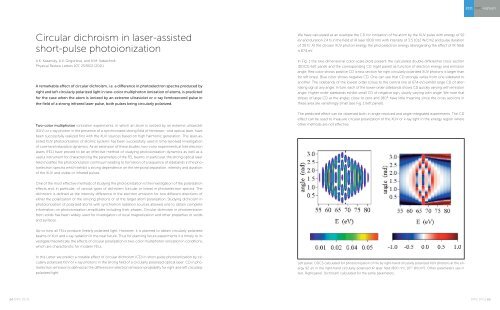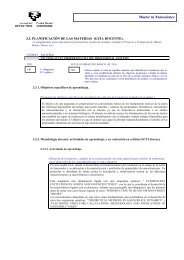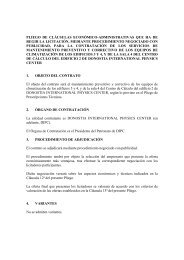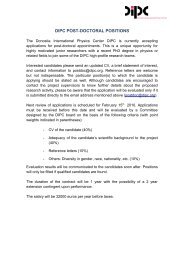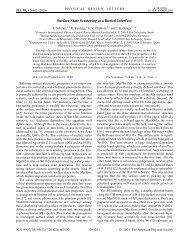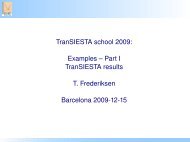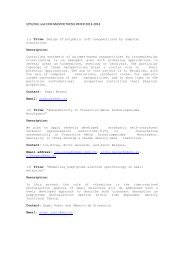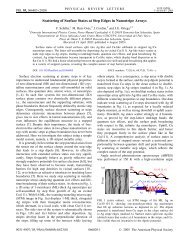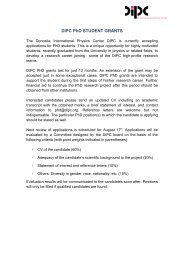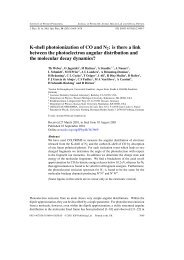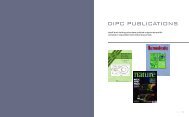Complete report - Donostia International Physics Center - Euskal ...
Complete report - Donostia International Physics Center - Euskal ...
Complete report - Donostia International Physics Center - Euskal ...
You also want an ePaper? Increase the reach of your titles
YUMPU automatically turns print PDFs into web optimized ePapers that Google loves.
2011 DIPC Highlight<br />
Circular dichroism in laser-assisted<br />
short-pulse photoionization<br />
A.K. Kazansky, A.V. Grigorieva, and N.M. Kabachnik<br />
Physical Review Letters 107, 253002 (2011)<br />
A remarkable effect of circular dichroism, i.e. a difference in photoelectron spectra produced by<br />
right and left circularly polarized light in two-color multiphoton ionization of atoms, is predicted<br />
for the case when the atom is ionized by an extreme ultraviolet or x-ray femtosecond pulse in<br />
the field of a strong infrared laser pulse, both pulses being circularly polarized.<br />
We have calculated as an example the CD for ionization of He atom by the XUV pulse with energy of 92<br />
eV and duration 2.4 fs in the field of IR laser (800 nm) with intensity of 3:5 1012 W/cm2 and pulse duration<br />
of 30 fs. At the chosen XUV photon energy the photoelectron energy (disregarding the effect of IR field)<br />
is 67.4 eV.<br />
In Fig. 1 the two-dimensional color-scale plots present the calculated double-differential cross section<br />
(DDCS) (left panel) and the corresponding CD (right panel) as function of electron energy and emission<br />
angle. Red color shows positive CD (cross section for right circularly polarized XUV photons is larger than<br />
for left ones). Blue color shows negative CD. One can see that CD strongly varies from one sideband to<br />
another. The sidebands of the lowest order (close to the central line at 67.4 eV) exhibit large CD of alternating<br />
sign at any angle. In turn, each of the lower-order sidebands shows CD quickly varying with emission<br />
angle. Higher order sidebands exhibit small CD of negative sign, slowly varying with angle. We note that<br />
stripes of large CD at the angles close to zero and 180◦ have little meaning since the cross sections in<br />
these area are vanishingly small [see Fig. 1 (left panel)].<br />
Two-color multiphoton ionization experiments, in which an atom is ionized by an extreme ultraviolet<br />
(XUV) or x-ray photon in the presence of a synchronized strong field of femtosec- ond optical laser, have<br />
been successfully realized first with the XUV sources based on high harmonic generation. The laser-assisted<br />
XUV photoionization of atomic systems has been successfully used in time-resolved investigation<br />
of core-level relaxation dynamics. As an extension of these studies, two-color experiments at free electron<br />
lasers (FEL) have proved to be an effective method of studying photoionization dynamics as well as a<br />
useful instrument for characterizing the parameters of the FEL beams. In particular, the strong optical laser<br />
field modifies the photoionization continuum leading to formation of a sequence of sidebands in the photoelectron<br />
spectra which exhibit a strong dependence on the temporal separation, intensity and duration<br />
of the XUV and visible or infrared pulses.<br />
The predicted effect can be observed both in angle resolved and angle-integrated experiments. The CD<br />
effect can be used to measure circular polarization of the XUV or x-ray light in the energy region where<br />
other methods are not effective.<br />
One of the most effective methods of studying the photoionization is the investigation of the polarization<br />
effects and, in particular, of various types of dichroism (circular or linear) in photoelectron spectra. The<br />
dichroism is defined as the intensity difference in the electron emission for two different directions of<br />
either the polarization of the ionizing photons or of the target atom polarization. Studying dichroism in<br />
photoionization of polarized atoms with synchrotron radiation sources allowed one to obtain complete<br />
information on photoionization amplitudes including their phases. Circular dichroism in photoemission<br />
from solids has been widely used for investigation of local magnetization and other properties of solids<br />
and surfaces.<br />
Up to now all FELs produce linearly polarized light. However, it is planned to obtain circularly polarized<br />
beams of XUV and x-ray radiation in the near future. Thus for planning future experiments it is timely to investigate<br />
theoretically the effects of circular polarization in two-color multiphoton ionization in conditions,<br />
which are characteristic for modern FELs.<br />
In this Letter we predict a notable effect of circular dichroism (CD) in short-pulse photoionization by circularly<br />
polarized XUV or x-ray photons in the strong field of a circularly polarized optical laser. CD in photoelectron<br />
emission is defined as the difference in electron emission probability for right and left circularly<br />
polarized light.<br />
Left panel: DDCS calculated for photoionization of He by right-hand circularly polarized XUV photons at the energy<br />
92 eV in the right-hand circularly polarized IR laser field (800 nm, 10 12 W/cm 2 ). Other parameters see in<br />
text. Right panel: Dichroism calculated for the same parameters.<br />
64 DIPC 10/11<br />
DIPC 10/11 65


